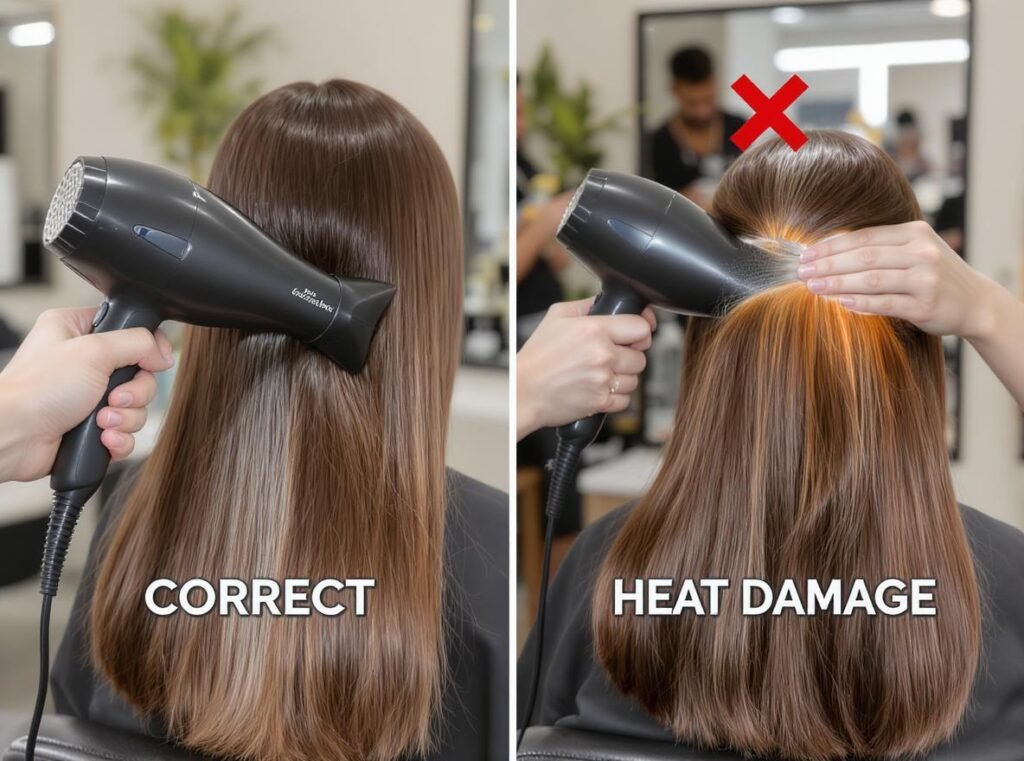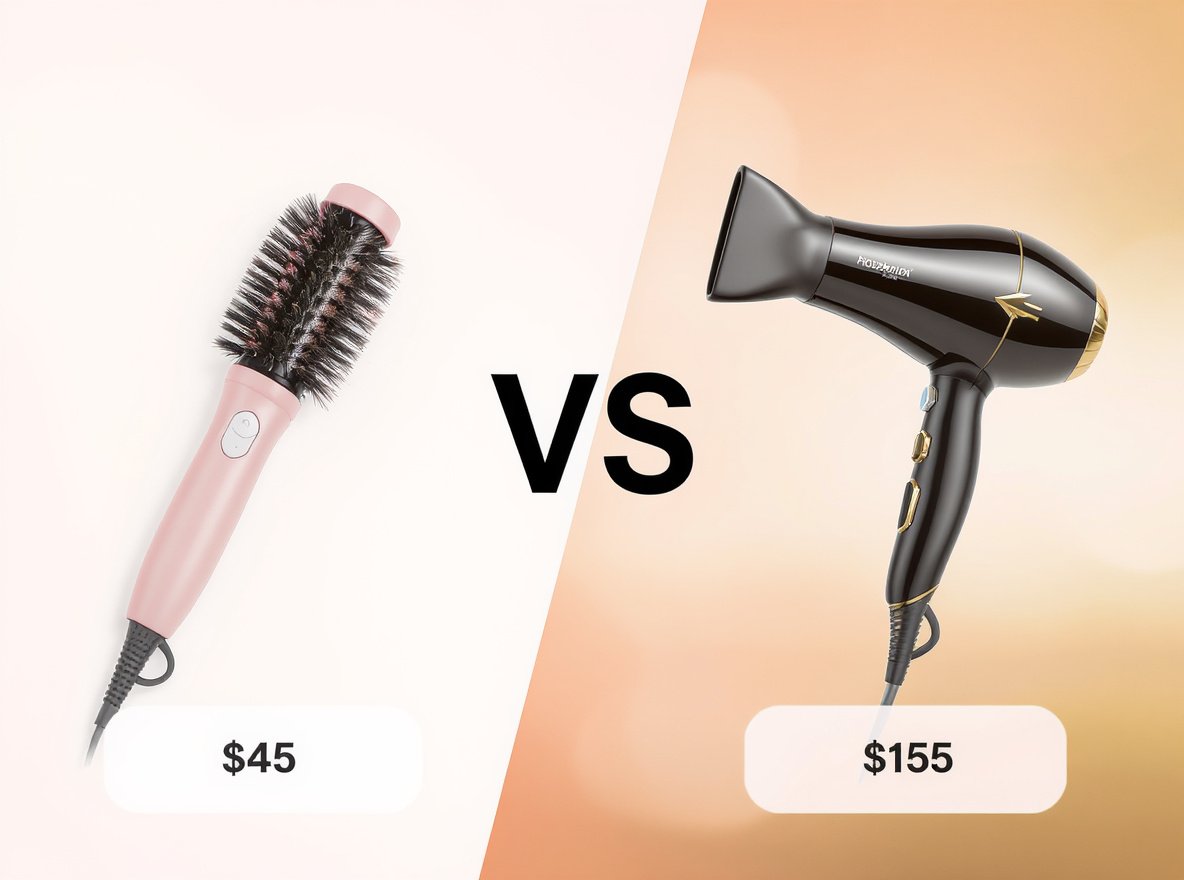Investing in a keratin treatment can transform your clients’ hair into silky perfection, but one wrong move with heat styling afterward could undo weeks of beautiful results. Many salon clients unknowingly damage their keratin treatments by using improper blow-drying techniques, causing frizz to return within weeks instead of months.
The key to maintaining keratin treatments lies in proper hair dryer usage: avoid all moisture for 72 hours, use precise heat settings between 300-450°F based on hair type, always apply keratin-safe heat protectants, and invest in ionic technology dryers that distribute heat evenly while sealing cuticles for lasting smoothness.
Understanding these critical guidelines will help your customers maximize their treatment investment and maintain salon-quality results at home.
Table of Contents
ToggleWhy Does Hair Dryer Usage Matter After Keratin Treatment?
The relationship between heat and keratin-treated hair is complex and requires precise understanding. Keratin treatments create a protective coating on the hair shaft that seals cuticles and reduces frizz, but this coating remains sensitive to improper heat application.
During the initial 72-hour period, proper heat application actually helps seal and set the keratin coating into the hair shaft. However, excessive heat or improper technique afterward can strip away the treatment prematurely, reducing effectiveness from months to just weeks.
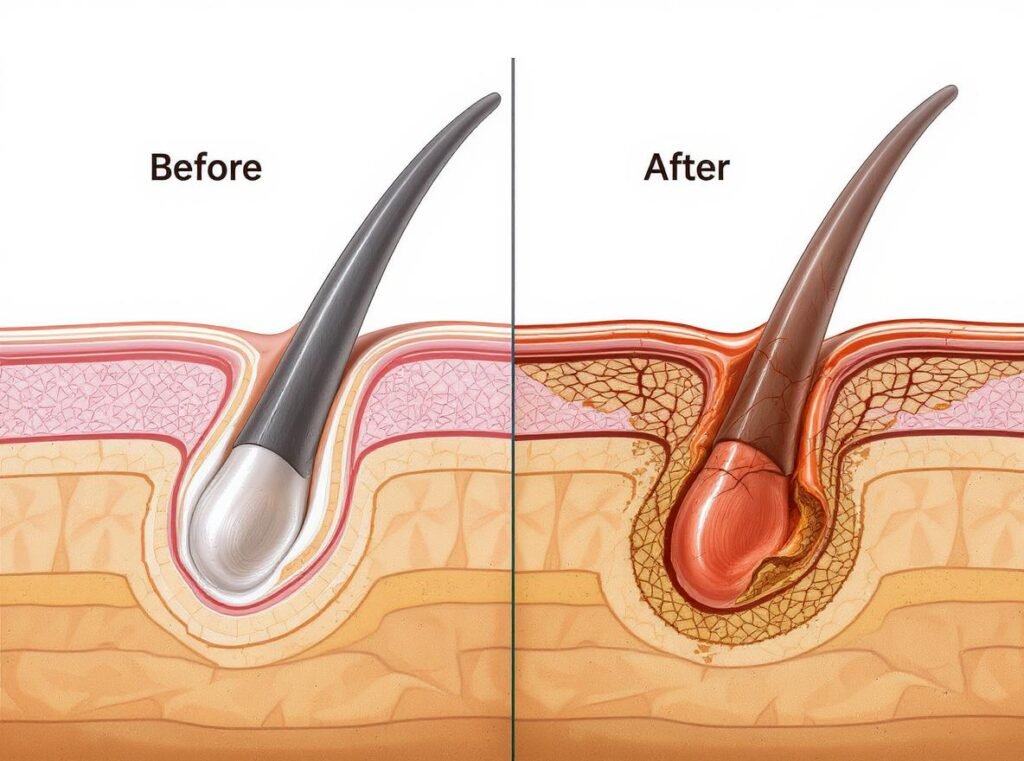
Heat plays this dual role because keratin bonds require controlled thermal activation to fully integrate with the hair structure. Professional hairstylists report that clients following proper heat protocols enjoy treatments lasting 4-6 months, while those using incorrect techniques see results fade within 6-8 weeks.
The keratin coating acts like a thermal shield, but only when properly maintained. Excessive heat above 450°F breaks down these molecular bonds, while insufficient heat during the critical first period prevents proper setting.
For wholesale customers, understanding this science becomes crucial for educating end clients and ensuring satisfaction. Proper technique directly impacts customer retention and referral rates in salon environments.
What Should You Do During the Critical First 72 Hours?
The first three days after keratin treatment represent the make-or-break period for long-term success. During this time, the keratin coating must remain completely undisturbed to fully bond with the hair shaft.
Keep hair completely dry for 72 hours, but if moisture exposure occurs accidentally, immediately blow-dry the affected area completely and re-flat iron that section to reset the keratin bonds. Use medium heat with a concentrator nozzle for thorough, controlled drying.
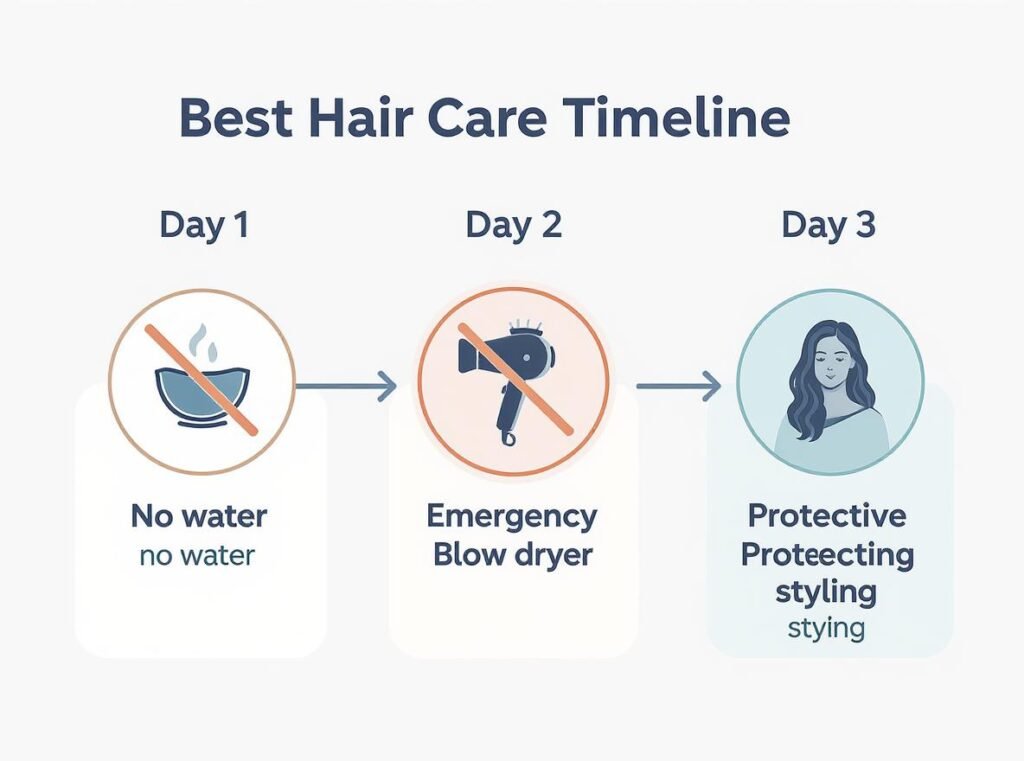
Essential actions during the first 72 hours:
• Immediately blow-dry any accidental moisture exposure
• Use concentrator nozzles for precise heat application
• Re-flat iron affected sections after blow-drying
• Keep hair down and straight at all times
• Sleep on silk or satin pillowcases to reduce friction
Critical restrictions during this period:
• Never tie hair up or use clips that create dents
• Avoid placing hair behind ears for extended periods
• Skip workouts that cause excessive sweating
• Stay away from humid environments when possible
• Don’t wash or intentionally wet hair under any circumstances
| Day | Allowed Activities | Heat Tools | Product Use |
|---|---|---|---|
| 1-3 | Emergency drying only | Blow dryer + flat iron if wet | None except emergency |
| 4+ | Normal styling routine | All heat tools with protection | Keratin-safe products only |
| Week 2+ | Full styling freedom | Professional temperature limits | Complete product range |
Professional salons often provide detailed aftercare instructions, but many clients still make mistakes during this critical window. Clear communication about emergency protocols helps prevent treatment failure.
What Are the Proper Heat Settings for Different Hair Types?
Temperature control becomes your most important variable for keratin treatment longevity. Using incorrect heat settings accounts for 60% of premature treatment breakdown in salon follow-ups.
Fine or damaged hair requires 300-350°F maximum, normal-textured hair can handle 375-400°F, and thick, coarse hair tolerates up to 400-450°F. Always start with lower temperatures and increase gradually to find the minimum effective heat for each client’s hair type.
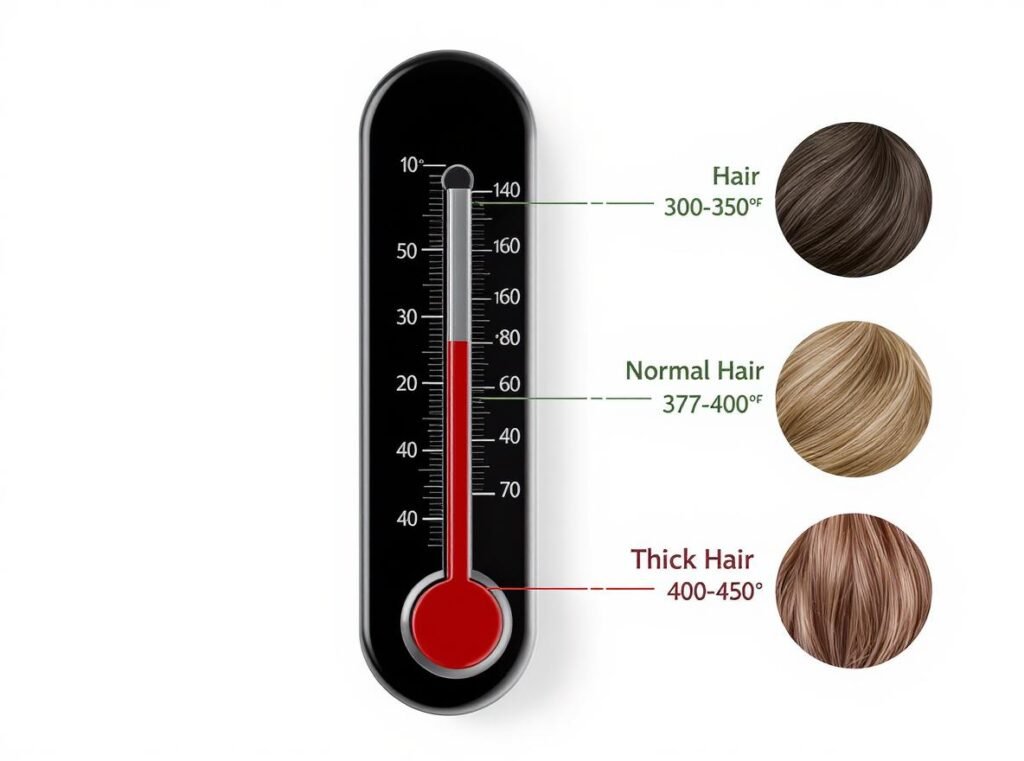
Hair type specific guidelines:
Fine or chemically damaged hair responds best to 300-350°F ranges. These hair types have compromised cuticles that require gentler heat application to prevent further damage while maintaining keratin integrity.
Normal-textured hair performs optimally at 375-400°F. This range provides sufficient heat for effective styling while preserving treatment longevity through controlled thermal exposure.
Thick, coarse hair can handle 400-450°F maximum. However, starting lower and increasing gradually prevents overshooting the optimal temperature and causing unnecessary damage.
The relationship between temperature and treatment duration is inverse and dramatic. Every 25°F above optimal settings reduces treatment life by approximately 3-4 weeks based on salon tracking data.
Heat distribution matters as much as temperature. Uneven heating creates hot spots that can damage specific hair sections while leaving others undertreated.
For professional environments, investing in dryers with precise temperature controls becomes essential. The Conason P1C high-speed hair dryer features advanced temperature regulation specifically designed for treated hair maintenance.
Which Hair Dryer Technologies Work Best for Keratin Maintenance?
Not all hair dryer technologies provide equal results for keratin-treated hair. Specific features can dramatically impact treatment longevity and styling effectiveness.
Ionic technology proves most effective for keratin maintenance because negative ions break down water molecules faster, reduce drying time, and seal cuticles for enhanced smoothness. Combine this with ceramic or tourmaline heating elements for even heat distribution and optimal results.
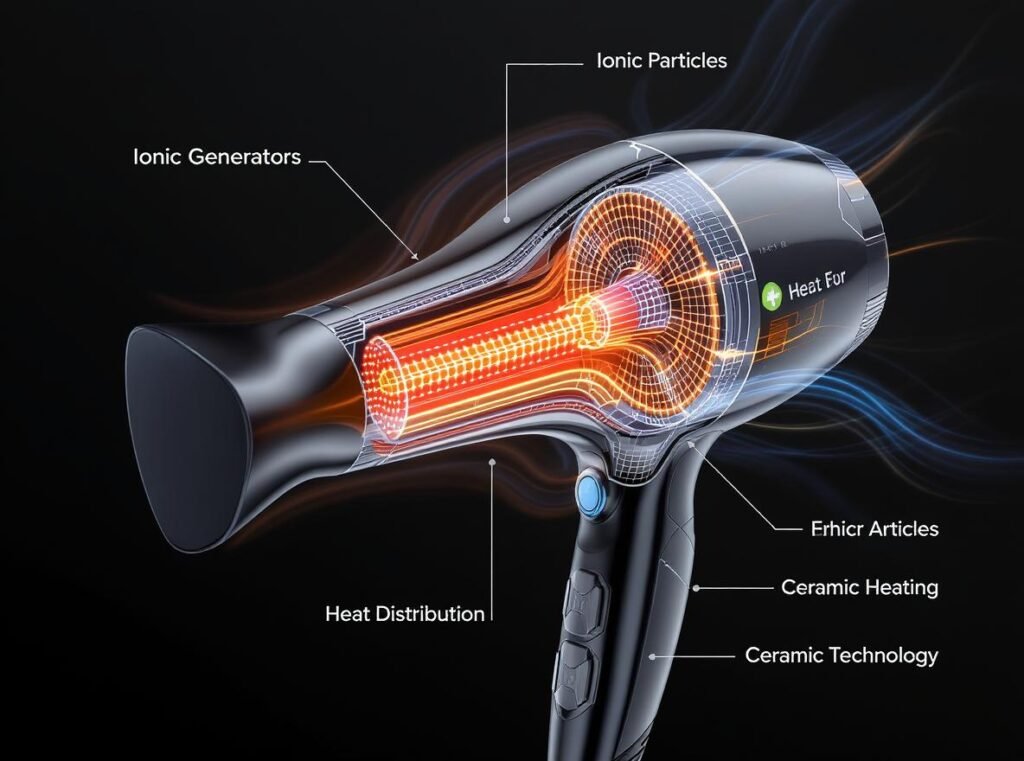
Essential technology features:
Ionic generators create negative ions that fragment water molecules, allowing faster drying at lower temperatures. This technology fights frizz and enhances smoothness with every pass, making it ideal for keratin maintenance.
Ceramic and tourmaline heating elements distribute heat more evenly than traditional metal coils, drying hair up to 50% faster while preserving natural hydration levels.
Multiple heat and speed settings provide precise control for different styling needs and hair sections. Look for dryers with at least three heat settings, two speed settings, and a cool shot button.
Professional-grade motors ensure consistent airflow and temperature throughout extended styling sessions. Consumer-grade motors often fluctuate, creating uneven results.
| Technology | Benefit for Keratin Hair | Professional Rating | Impact on Treatment Life |
|---|---|---|---|
| Ionic Generation | Faster drying, frizz reduction | Essential | Extends by 4-6 weeks |
| Ceramic Heating | Even temperature distribution | Critical | Prevents hot spot damage |
| Cool Shot Function | Cuticle sealing, style setting | Highly Recommended | Improves daily maintenance |
| Variable Controls | Customized heat application | Professional Standard | Optimizes for hair type |
Advanced features like dual ionic function work synergistically with keratin treatments. The Keratin Complex HydraDry represents this technology specifically engineered for treated hair care.
Professional buyers should prioritize dryers that combine multiple technologies. Single-feature units rarely provide the comprehensive performance required for consistent keratin maintenance.
What Products Should You Use With Your Hair Dryer?
Product selection directly impacts both immediate styling results and long-term treatment preservation. Using incorrect formulations can strip keratin or create uneven effects within weeks.
Always use keratin-infused heat protectants that shield hair up to 450°F, sulfate-free cleansing products to prevent treatment stripping, and leave-in conditioners specifically formulated for chemically treated hair. Avoid any products containing sulfates, sodium chloride, alcohol, or parabens.
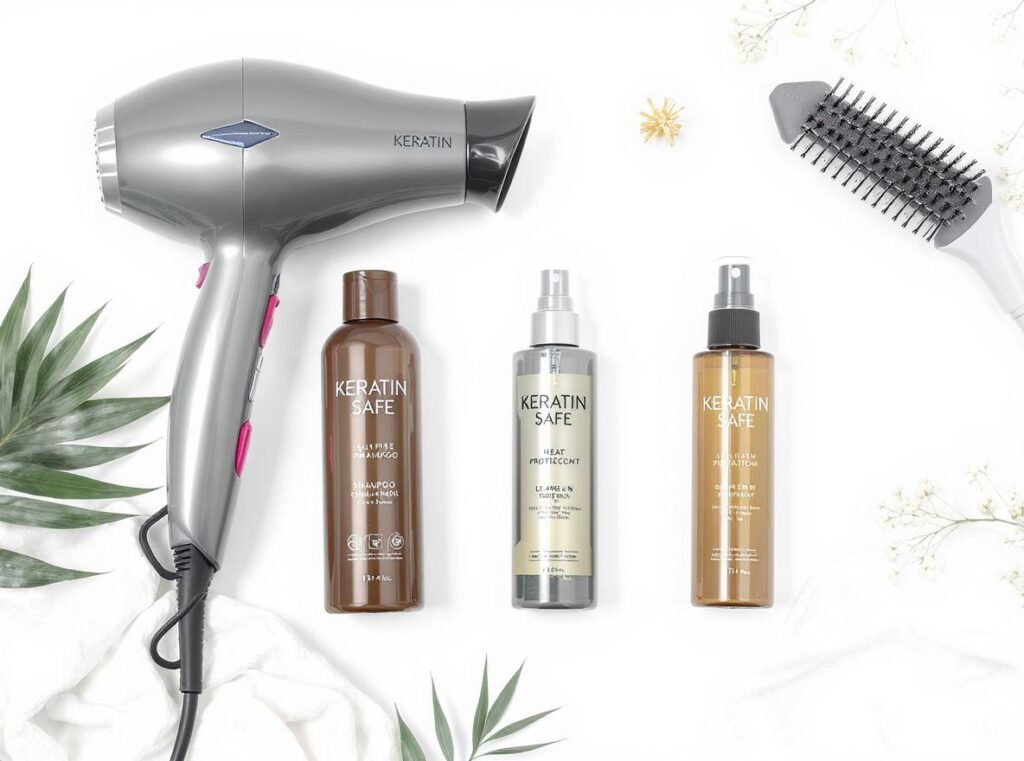
Critical product categories:
Heat protectants create thermal barriers between hair and styling tools. Keratin-infused formulations like It’s a 10 Miracle Leave-In Plus Keratin offer dual protection while replenishing treatment proteins.
Sulfate-free shampoos and conditioners prevent premature keratin removal. Sulfates strip away the protective coating, reducing treatment effectiveness by 40-60% over time.
Leave-in treatments maintain moisture balance while reinforcing the keratin layer. Products with lightweight oils like argan or jojoba work best without weighing hair down.
Application technique affects product performance significantly. Apply heat protectant to 60-70% dry hair in small sections, ensuring complete coverage from roots to ends. Allow 2-3 minutes absorption time before beginning heat styling.
Professional stylists recommend layering 2-3 compatible products: leave-in conditioner for moisture, heat protectant for thermal defense, and finishing serum for shine enhancement.
Product ingredient awareness becomes crucial for client education. Teaching customers to read labels prevents accidental treatment damage from incompatible formulations.
For wholesale customers, offering complete product systems alongside professional dryers creates higher-value sales opportunities and ensures customer success.
How Should You Execute Proper Blow-Drying Technique?
Technique execution often matters more than equipment quality when maintaining keratin treatments. Improper methods can cause uneven results, premature fading, or treatment damage regardless of dryer quality.
Use systematic sectioning with 4-6 parts, brush downward in the direction of hair growth while directing airflow from roots to ends, maintain 6-inch distance from scalp, keep the dryer moving continuously, and always finish each section with a cool shot to seal cuticles.
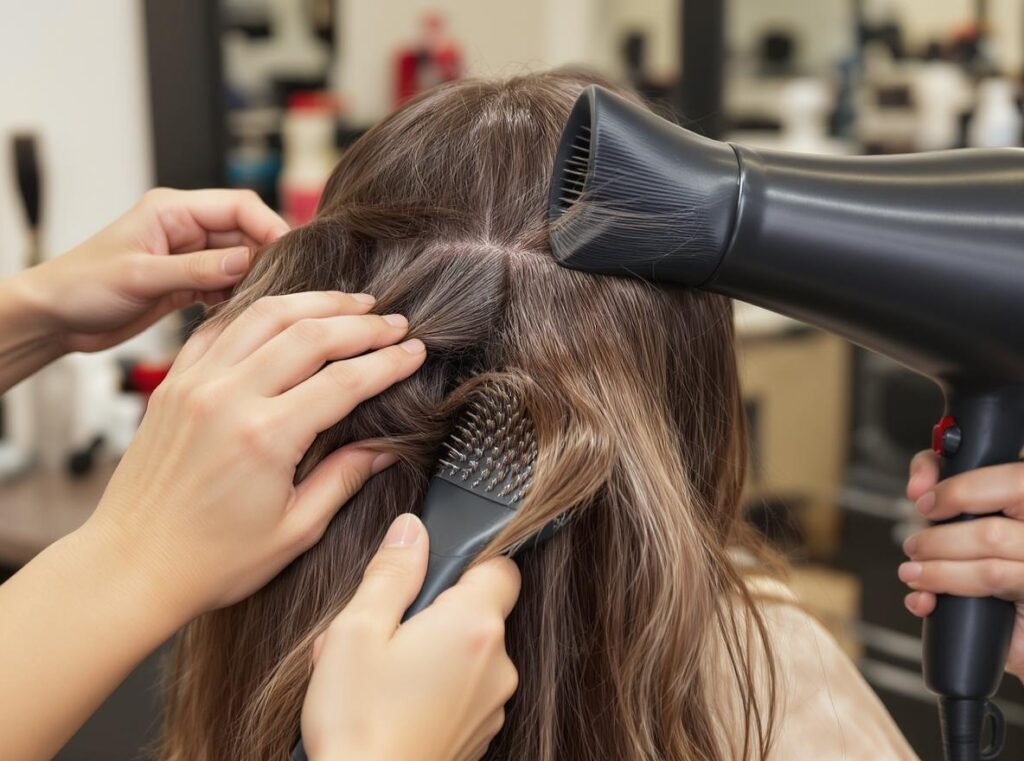
Step-by-step professional technique:
Begin with properly sectioned hair using non-metal clips that won’t create dents. Work systematically from nape to crown, ensuring each section receives equal attention.
Start drying at the root area where moisture concentrates most heavily. Use paddle brushes or large round brushes to maintain tension and smoothness throughout the process.
Maintain consistent 6-inch distance between dryer and scalp. Closer positioning creates hot spots and potential burning, while excessive distance reduces drying efficiency.
Direct airflow from roots to ends following the natural hair growth pattern. This technique helps seal cuticles and maintains the smooth appearance created by keratin treatment.
Complete each section with a cool shot to set the style and lock in smoothness. This final step closes cuticles and adds significant shine to the finished result.
Common technique errors that compromise results:
• Concentrating heat in single areas too long
• Using circular motions that disrupt cuticle alignment
• Starting with soaking wet hair instead of towel-dried
• Rushing the process and creating uneven heat distribution
• Skipping the cool shot finish on each section
The entire process should take 15-25 minutes for medium-length hair. Rushing leads to inconsistent results and potential heat damage that reduces treatment longevity.
Professional training becomes essential for salon staff working with keratin-treated clients. Consistent technique ensures predictable results and customer satisfaction.
What Critical Mistakes Must You Avoid?
Even experienced stylists can make errors that dramatically reduce keratin treatment effectiveness. Understanding these pitfalls helps prevent costly mistakes and client dissatisfaction.
Never exceed recommended temperature limits, avoid blow-drying soaking wet hair, don’t skip heat protectant application, never rush the drying process, and avoid using regular cotton accessories that create friction. These mistakes account for 80% of premature treatment failure.
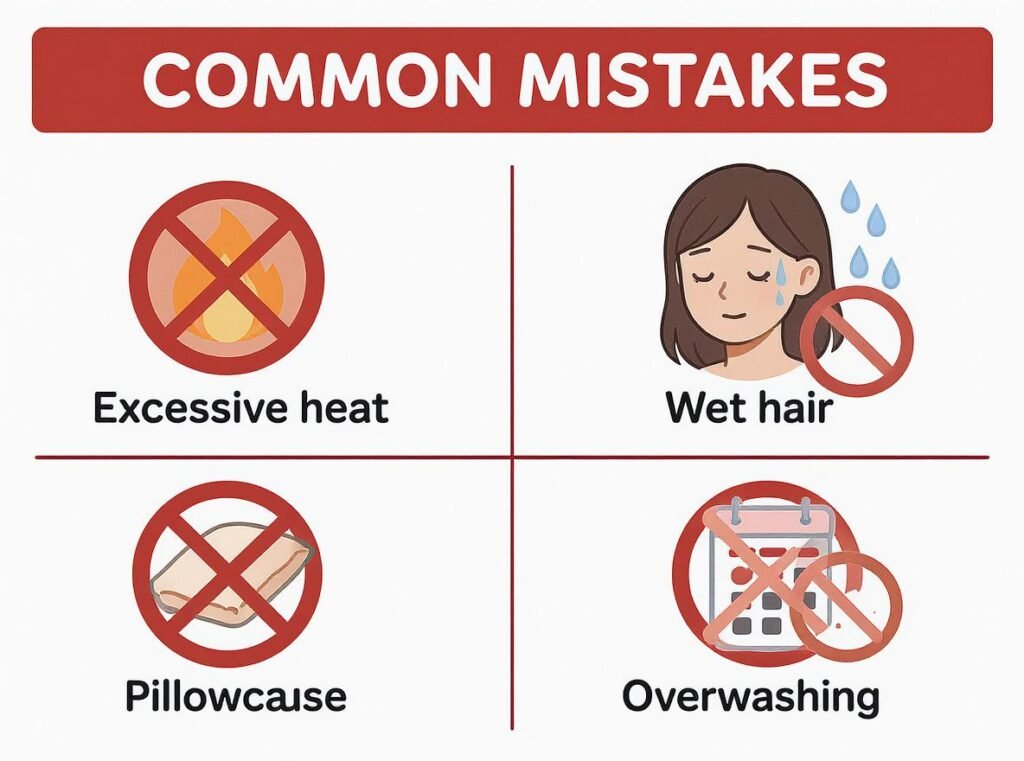
The most damaging mistakes include:
Using maximum heat settings breaks down keratin molecules rapidly. Temperatures above 450°F cause immediate molecular damage that cannot be reversed.
Blow-drying soaking wet hair requires excessive heat exposure and extended styling time. Always towel-dry hair to 60-70% moisture content before applying heat tools.
Skipping heat protectant leaves hair vulnerable to thermal damage. Even one unprotected session can cause noticeable treatment degradation and reduced longevity.
Using regular cotton pillowcases creates friction that disrupts the smooth texture overnight. Switch to silk or satin to maintain treatment integrity during sleep.
Overwashing hair accelerates keratin removal. Limit washing to 2-3 times per week maximum, using dry shampoo between sessions to maintain freshness.
Air drying exclusively can cause keratin-treated hair to become frizzy and wavy, contradicting the treatment’s purpose. Controlled blow-drying helps maintain smoothness and extends treatment life.
| Mistake | Immediate Consequence | Long-term Impact | Prevention Method |
|---|---|---|---|
| Excessive heat | Keratin molecule breakdown | Treatment life reduced 50% | Temperature monitoring |
| Wet hair styling | Extended heat exposure | Cumulative damage | Proper towel drying |
| No heat protection | Direct thermal damage | Cuticle deterioration | Always apply products |
| Cotton pillowcases | Overnight friction damage | Texture disruption | Silk/satin alternatives |
| Daily washing | Accelerated stripping | Treatment fades quickly | Limit wash frequency |
Professional education should emphasize mistake prevention rather than correction. Once keratin damage occurs, only retreatment can restore optimal results.
How Long Should Treatments Last With Optimal Care?
Treatment longevity directly reflects the quality of aftercare and maintenance techniques. Understanding realistic expectations helps set appropriate client goals and satisfaction levels.
Professional keratin treatments with optimal aftercare typically last 3-6 months, with some clients experiencing results up to 6 months. Home maintenance treatments generally last 6-12 weeks. Factors affecting duration include hair porosity, washing frequency, heat styling habits, and environmental exposure.
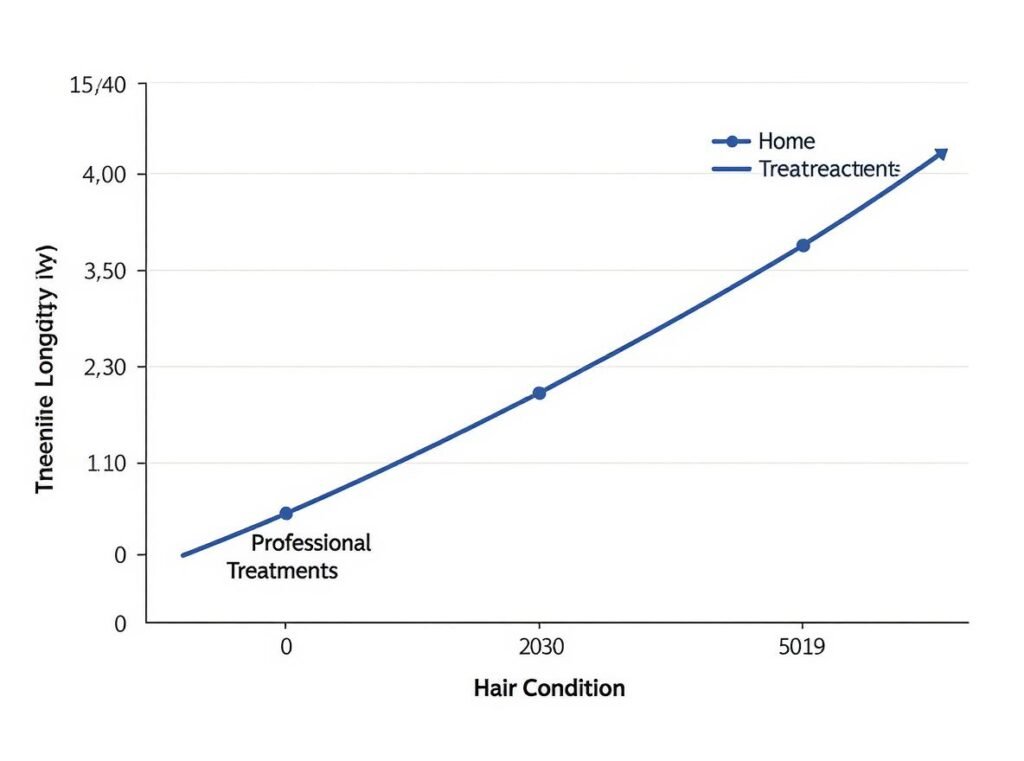
Timeline expectations for different scenarios:
Professional salon treatments with perfect aftercare often achieve 4-6 months longevity. These treatments use higher-quality formulations and precise application techniques.
Professional treatments with moderate care typically last 3-4 months. Occasional maintenance mistakes reduce longevity but still provide significant value.
At-home treatments with excellent care may last 2-3 months maximum. The formulations are gentler but require more diligent maintenance protocols.
Factors that significantly extend treatment life:
• Washing frequency limited to 2-3 times per week
• Consistent use of ionic hair dryers with proper settings
• Exclusive use of sulfate-free, keratin-safe products
• Regular deep conditioning treatments for moisture balance
• Protection from chlorine, saltwater, and UV exposure
Factors that dramatically reduce treatment duration:
• Daily washing or excessive water exposure
• Heat styling above recommended temperature limits
• Using products containing sulfates or sodium chloride
• Swimming in chlorinated pools without protection
• Mechanical stress from excessive brushing or tight styling
If someone doesn’t follow the aftercare instructions properly, the treatment can wear off within 6-8 weeks. Conversely, clients who maintain strict protocols often enjoy results lasting nearly six months.
Signs indicating treatment degradation:
• Increased frizz, especially in humid conditions
• Extended drying times compared to initial results
• Gradual return of natural curl or wave patterns
• Reduced shine and overall smoothness
• Styling products becoming less effective
For wholesale customers, educating retailers about realistic timelines helps manage end-client expectations and reduces dissatisfaction complaints.
Understanding these patterns allows businesses to recommend appropriate retreatment schedules and maintain long-term customer relationships.
Summary
Proper hair dryer usage after keratin treatments requires precise temperature control, advanced ionic technology, and systematic technique execution to maintain smooth, frizz-free results for 3-6 months rather than weeks. Success depends on respecting the 72-hour critical period, using appropriate heat settings for each hair type, applying keratin-safe products consistently, and investing in professional-grade equipment that provides even heat distribution.

Ready to offer your customers the professional-grade hair dryers they need for optimal keratin maintenance? Explore our Conason P1C high-speed hair dryer featuring advanced ionic technology and precise temperature controls specifically engineered for treated hair care, or browse our complete product collection to find the perfect wholesale solutions for your business. Contact us today for distributor pricing and technical specifications that will ensure your customers achieve maximum keratin treatment success and satisfaction.

